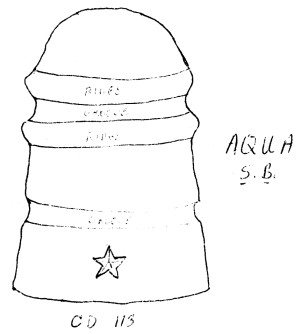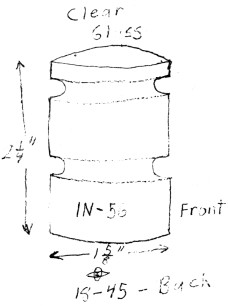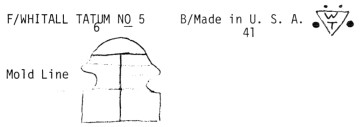Questions Answered by N. R. Woodward
Author of The Glass Insulator in America and originator of C.D. #'s (Consolidated Design Numbers)
Reprinted from "INSULATORS - Crown Jewels of the Wire", May 1978, page 10
Wayne L. Barnes, Hamler, Ohio, writes: I would like to ask about the
insulator pictured below.
I wrote the Milhollands about it a while back, and I told them it was a star
CD 113 insulator. She told me I might have mistaken it for a CD 112.
Well, this time I drew a picture of it. As you can see, it is a CD 113. There
is just one star on the front. (The S.B. stands for smooth base.

I just want to know if it was left out of Milholland's book by mistake, or
what (3rd Revision).
Please let me know what you find out. I don't know if it is rare or common.
My wife and I were at a flea market recently, and I purchased an insulator I
cannot locate in Milholland's 3rd Revision. It is a C.D. 121 Toll insulator,
inscribed as follows: F-HEMINGRAY B-PATENT MAY 2 1893. The color is aqua, and
there is a considerable amount of "snow" in the glass. It also has
sharp drip points.
Please send any information possible about this insulator that you may find.
It would be very much appreciated.
- - - - - - - - -
In reply to Wayne L. Barnes: Yes, of course, you have a Star CD #113. I've
had this item in my collection for years. As to why it was left out of
Milholland's book, I can't say; but I can say that they aren't plentiful and
make an addition to your Star line of which you can be proud. The Star CD #112
is far more common.
As you know, the CD #131 style was developed for the early telephone
"long lines", or toll lines, as they spread over the country in the
1890's and early part of this century. Most of them were embossed AM. TEL. &
TEL. CO.; but you have one of the early Hemingrays. This item, embossed as you
describe, isn't rare; but it's a tough one to find in mint condition.
Dean Meneilley, Belleville, Ontario, Canada, states: One insulator you
may be able to help me with is a C.D. 154 Hemingray 42, in a just off clear
color (line 1714). This insulator lists as $95.00. I cannot see why it is just
so much. Maybe you can help me?
- - - - - - - - -
In reply to Dean Meneilley: The item listed in line 1714, 1976 Milholland
Price List, is described as "like E14-B". That indicates that it is of
a special glass, probably fused silica, similar to the experimental CD #128 that
were embossed E14-B. Since I haven't seen this item, I can't make a first-hand
statement; but a Hemingray-42 made of that type of glass would not be a regular
production item and would undoubtedly be rare.
From Michael T. Vander Horst, Napolian, Ohio: I have found a CD 145
Beehive that I can't find in Milholland's book. The description is:
Brookfield--F--Crown Arc. --W. Brookfield/ 45 Cliff St/N.Y.--B--Crown
Side Number (20)/PATD NOV 13th 1883/FEB 12th 1884--M.L.O.D.--Inner
skirt has 4 equal spaced small sharp drip points--Green.
The description is almost the same as Line 1419 in Milholland's 1976 Price
Guide. Do you, or any of your readers, have an insulator like this, or know the
value of it?
- - - - - - - - -
In reply to Michael T. Vander Horst: Your Brookfield CD #145 isn't
particularly scarce. It comes from a common mold group. Of course, as with any
of these Brookfields, you might look a long time before you found one with a
particular shop number (yours is 20); but I've seen this one quite often. Things
to look for on these are sharp embossing and unusual color. The discouraging
thing about the crown-embossed CD #145 Brookfields is that so many have very
weak, almost illegible embossing.
Carolyn Theesen, Lawton, Oklahoma, has five questions: 1) On a Whitall
Tatum Co No 1, what does the  under Tatum stand for? 2) Also in Tatum, some of the T's are like this
under Tatum stand for? 2) Also in Tatum, some of the T's are like this  and some are like this
and some are like this  .
Is this of any significance? 3) Could you please tell me what S.C.A. on
insulators stands for? 4) I have about 15 Armstrong DP 1 insulators, but only
one has Armstrong's written in slanted lettering with the s, and all the others
only have Armstrong with printed letters. Do you have an answer for this one? 5)
Also, on the back of the Armstrong DP 1 are numbers such as 7-68 57 61 and so
on. What do these stand for? .
Is this of any significance? 3) Could you please tell me what S.C.A. on
insulators stands for? 4) I have about 15 Armstrong DP 1 insulators, but only
one has Armstrong's written in slanted lettering with the s, and all the others
only have Armstrong with printed letters. Do you have an answer for this one? 5)
Also, on the back of the Armstrong DP 1 are numbers such as 7-68 57 61 and so
on. What do these stand for?
- - - - - - - - - -
In reply to Carolyn Theesen: On the Whitall Tatum insulator that you
describe, 4 is the mold number. When they make up a set of molds, they number
them serially. That gives them an immediate identification of the mold at fault
in case insulators come off the press with a defect. A mold set may consist of
any number of molds, depending on how many insulators of that style were being
made at the time.
The variation in the letter T would have no significance. The differing
styles could have been made by different mold engravers.
The letters C.S.A. on CD #128 indicate that the insulator was designed for Carrier
service and for use on a Steel pin. We are not so sure of the third
letter; but it seems to have been added to identify a specific mold group. Later
insulators, with extremely minor variations, are embossed C.S.C. and C.S.O.
The Armstrong's DP 1 with the slanted letters were last made in the 1952 mold
set. Subsequent mold sets were engraved with the circled A and printed letters.
Both were used for some years and are common.
The small numbers on the Armstrong insulators are the mold and date codes.
The numbers 57 61 would indicate mold number 57 of the 1961 mold set. If there
are dots after the 61, add one year per dot. For example, 57 61::: would
indicate that the insulator was made in 1967.

Bob Berry, Jr., of Bethlehem, Pennsylvania, writes: I have just
acquired some insulators I cannot find in Milholland's.
The first one looks like some sort of electric fence insulator. I would
appreciate any information as to it's use or rarity. It has a pin hole about the
size of Surge insulators, and it is embossed IN-56 on the front and has Owens
Illinois trademark over 18-45 on the back.
The second insulator is a C.D. 124 embossed:
F- Hemingray / No. 13
B- Patent / May 2 1893
It is definitely C.D. 124, not 124.2 as listed. It is absolutely identical
with the usual No. 4 of this style, except for the 13. Under the 13 there is
evidence of a blot-out. Perhaps the 4 was blotted out and the 13 put in.
The last insulator is C.D. 252 No. 2 Cable in ice green. Have many of
these been found?
- - - - - - - - - -
In reply to Bob Berry, Jr.: Your IN-56 is only part of an insulator. They
were never sold with just the glass, but were fitted with a steel pin which was
cemented in with metallic cement. The pin has lag screw threads so these little
insulators could be attached to any pole, tree, or wood building. They were used
by the military in the 1940's, and later many showed up in surplus stores. They
were subsequently used on private rural phone lines to some extent and very
possibly, as you suggest, for electric fences.
No. 13 was the last number used for CD #124. Not so many were made during
those later years, and the ones with No. 13 are much more scarce. You are
probably entirely correct about a 4 having been covered in the mold and replaced
with the 13.
The CD #252 No. 2 CABLE you describe may be Canadian. Dominion made some of
these embossed exactly as the Brookfields were, but of the typical light green
and straw Dominion colors.

Fred A. Escher, Sun Prairie, Wisconsin, writes: Enclosed is a picture
of two insulators I obtained at a recent bottle show here in Wisconsin. I cannot
find any information on these two insulators, so wonder if you can help out with
a CD number, manufacturer and approximate value.
The insulators are 2.7 inches across the base, 4.2 inches high, with the
center of the wire groove being 2.5 inches from the base. Both insulators have a
1/2 bar, a 3/4 bar and then a close grouped series of four 1 inch
(approximately) bars on the inside of the skirt. There are no other markings.
They are light blue or aqua in color, and the only physical difference is that
the insulator on the left has about a 1/8 inch rise in the glass right under the
wire groove.
Any information you can give on these insulators would be appreciated.
- - - - - - - - - -
In reply to Fred Escher: Your two unembossed CD #126.3 American Union Pattern
insulators have been found occasionally on old lines, mostly in the Midwest.
Nothing whatever is known of their origin. They would probably be between 80 and
100 years old; and chance for a positive identification seems small.
From John Palyo, Flushing, New York: My son John Vincent, age ten, has
found some insulators this past year that are not listed in Mr. Milholland's
ref. book or the new 1977 price list. I hope you or the readers of "Crown
Jewels" can provide some information concerning these insulators as to
scarcity and value. They are as follows:
1. CD 102 front/Brookfield, Back/New York, crown top backward #1 , color
Yellow Green.
2. CD 102, also a Brookfield, about 3/16" shorter than the rest of the
Brookfield CD 102's we have. The color is almost an Ice Blue. The embossing is
very large and bold on both sides, with Brookfield on the front and N.Y. on the
back, a backward number on the crown with a spot of glass on each side of it. I
will try to draw the crown top.

3. CD 121 A.T. & T. Co. in Green with both a Roman numeral and a number
on top of the crown, partially double embossed on an angle.

4. CD 164 Whitall Tatum No 5 in Clear, the embossing or it as follows:

The two dots on the top of the triangle are small, and two dots on the side
are large. But what really drew our attention is the mold line. It comes up the
side on both sides to about 3/4" above the wire groove, then completely
circles the dome.
- - - - - - - - -
In reply to John Palyo: The CD #102 Brookfields were made in such great
numbers for about 40 years that the variety is almost without limit. They vary
in size, embossing, and quite a range of markings were used as shop numbers.
Since these numbers were for the identification of the source of the insulators
as they were taken from the annealing lehr, and nothing further, they were an
internal code at the factory, and cannot be ascribed a specific meaning beyond
that. Shop markings commonly seen on CD #102 include numbers from 1 to 17; X0,
X1 and X2; and letters A, B, C and D. Added to that is the consideration that
much colored glass cullet was used at the Old Bridge plant. It becomes obvious
that no list, at least of the scope presently available, will be anywhere near
complete in exact descriptions of the Brookfield CD #102. While most of them
have no special value, they are fascinating and beautiful to collect. And you
can always be assured of finding one that is in some way different.
The A.T. & T. Co. CD #121 is also a Brookfield product and has the
typical Brookfield shop number on the crown. The "double embossing"
happens as the melted glass folds into the mold, and a surface will rest
momentarily against the engraving and pick up a partial embossing as it starts
to cool at the surface, before settling a fraction of a second later into its
final position in the mold.
Your Whitall Tatum No. 5 was made in mold #6, in 1941, and the four dots
around the triangle indicate fourth quarter production. So your insulator was
made about the time the United States entered World War II.
The mold line position you mention is quite common on Whitall Tatum
insulators. Quite often they show a mold line between the crown and mold halves
at a point above the upper wire groove lip, instead of on the crest of the lip
as is more common. Perhaps an old time mold maker could tell us why this was
done; but one effect would be to eliminate the possibility of a sharp ridge on
the lip, as happened with some earlier insulators.
| 